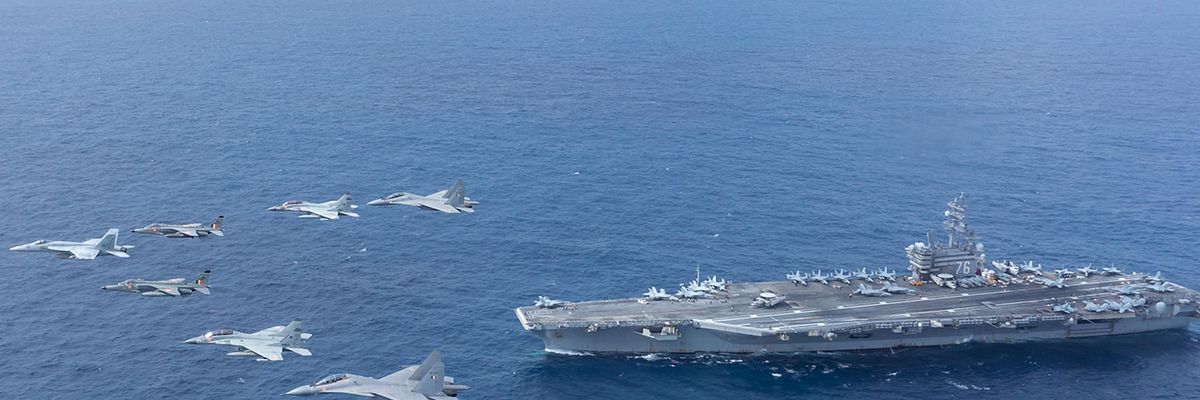Global military expenditures surpassed $2 trillion for the first time ever last year, with the United States spending more on its war-making capacity than the next nine nations combined, according to new data published Monday.
"Spending 12 times as much on our military as Russia didn't prevent a war in Europe. It just deprived us of resources at home."
The Stockholm International Peace Research Institute (SIPRI) reported an all-time high of $2.1 trillion in worldwide military spending for 2021, a 0.7% increase from 2020 levels and the seventh straight year of increased expenditures.
"Even amid the economic fallout of the Covid-19 pandemic, world military spending hit record levels," SIPRI senior researcher Diego Lopes da Silva said in a statement. "There was a slowdown in the rate of real-terms growth due to inflation. In nominal terms, however, military spending grew by 6.1%."
Tori Bateman, policy advocacy coordinator at the American Friends Service Committee, a Quaker group, said that "this year, we've seen how military spending fails to keep us safe. It's shameful that governments, especially the United States, continue to destabilize our world with more weapons, while failing to address climate change, public health, and other true global crises."
"It's time for the United States, and world leaders everywhere, to cut military spending and commit to solving our problems for real," she added.
With $801 billion--or 38% of total global military spending--the United States spent more in 2021 than the next nine nations combined: China ($293 billion), India ($76.6 billion), the United Kingdom ($68.4 billion), Russia ($65.9 billion), France ($56.6 billion), Germany ($56 billion), Saudi Arabia ($55.6 billion), Japan ($54.1 billion), and South Korea ($50.2 billion).
U.S. funding for military research and development increased by nearly a quarter between 2012 and 2021, while arms procurement expenditures fell by 6.4% over that same period, a trend that "suggests that the United States is focusing more on next-generation technologies," according to SIPRI researcher Alexandra Marksteiner.
"The U.S. government has repeatedly stressed the need to preserve the U.S. military's technological edge over strategic competitors," she added.
The latest SIPRI analysis comes weeks after U.S. President Joe Biden rejected progressive lawmakers' calls for Pentagon spending cuts and asked Congress to green-light more than $813 in new military spending for the next fiscal year--a $31 billion increase from current levels.
That amount includes nearly $146 billion for the procurement of new weaponry, including Lockheed Martin F-35 fighter jets, Northrup Grumman B-21 bombers, and Virginia-class nuclear-powered fast attack submarines manufactured by General Dynamics and Huntington Ingalls Industries.
The new SIPRI report also comes as some of the largest U.S. weapons makers are gearing up for what is expected to be a big earnings week as the West's response to the Russian invasion of Ukraine--providing Ukrainian forces with billions of dollars in weaponry--fuels arms industry profits.
Lindsay Koshgarian, director of the National Priorities Project at the Washington, D.C.-based Institute for Policy Studies, recently noted that "spending 12 times as much on our military as Russia didn't prevent a war in Europe. It just deprived us of resources at home."
"Even during a pandemic, supply chain crisis, and painful inflation, we'll put more resources into the military and war than public health, education, green jobs, affordable housing, scientific and medical research, child care, and every other domestic need--combined," she wrote. "This special treatment for the Pentagon recklessly squanders precious resources that could be used to strengthen our families and communities against our compounding crises at home."
Last week, an analysis by In These Times and Zain Rizvi at the consumer advocacy group Public Citizen revealed that the U.S. has spent 7.5 times more money on nuclear weapons than on global Covid-19 vaccine donations, despite Biden's pledge that "America will become the arsenal of vaccines as we were the arsenal of democracy during World War II."
"What's keeping us safe," asked Koshgarian, "Is it maintaining this huge nuclear stockpile or delivering these vaccines?"

